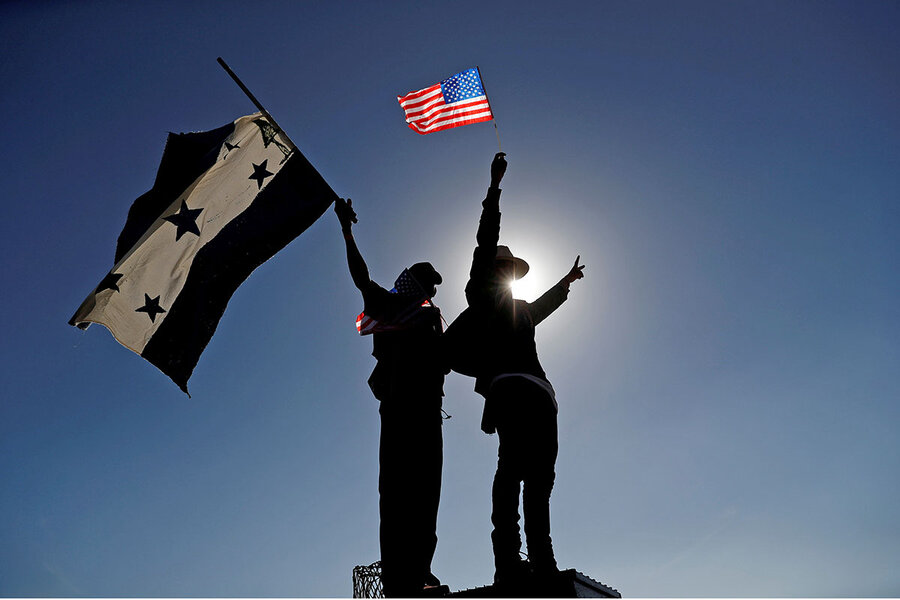Honduras coup: Why the 10-year anniversary matters today
Loading...
On Monday, the Trump administration announced a new rule for asylum-seekers at the southern border: people who pass through another country en route to the U.S. and fail to seek asylum there will not be eligible for U.S. protection.
Few people who leave home for the U.S. apply in countries like Guatemala, though more have sought refuge in Mexico in recent years. And many regional experts consider these transit countries unsafe, since they struggle with some of the challenges people are fleeing in the first place, like gang violence.
So how did those problems get so entrenched? History helps provide some clues. Take Honduras, which this summer marked 10 years since the ousting of a democratically elected president. It’s still feeling aftershocks from the crisis, which exacerbated deep political divides, weakened institutions, and fed a widespread lack of faith in elected officials.
Why We Wrote This
Why do migrants keep coming to the U.S., even as the border tightens? Across Central America, some factors seem the same: corruption, impunity, violence. But the backstory is different in each country – and key to understanding.
What happened in Honduras back in 2009?
In the early morning hours of June 28, military forces took then-President Manuel Zelaya from his home at gunpoint. Wearing his pajamas, he was placed under arrest and flown out of the country. Nations around the world condemned the move as a coup.
Mr. Zelaya was elected in 2006 as part of a center-right party that promised to fight crime. But while in office, he moved increasingly to the left. His efforts to organize a non-binding vote that could have opened the door to revising the constitution, which many feared would overturn term limits, was the last straw for many critics.
Violence jumped following the coup. The army and police took to the streets actively beating and detaining anyone perceived as protesting the new government. An official truth commission found the armed forces were responsible for at least 20 deaths in the days following Mr. Zelaya’s ousting.
In the following three years, murder rates shot up, earning Honduras the ignoble label of highest homicide rate in the world. By 2012, nearly 90 Hondurans out of every 100,000 were killed. Weak institutions, like the justice and security systems, and a general lack of political will in an environment of deep polarization are often blamed for the security crisis.
There were less headline-grabbing crackdowns as well. Some 123 land activists were killed between 2009 and 2017, often in indigenous communities protesting government-backed megaprojects, according to the international watchdog group Global Witness.
Has the bumpy road after the coup started to smooth out?
The implications – and roots – of the coup regularly resurface in Honduras.
The most recent presidential election threw salt on the wounds of many Hondurans who felt democracy was shattered with Mr. Zelaya’s ousting, underscoring still deep political fissures. President Juan Orlando Hernández successfully ran for reelection in 2017 – the very offense Mr. Zelaya was ousted over – after a Supreme Court ruling paved the way for a consecutive second term. Election results were contested by international bodies like the Organization of American States. (With 58% of the votes counted, an opposition candidate was leading Mr. Hernandez by 5%. The electoral court stopped releasing data for more than a day, and in their next update, JOH, as the president is known, had pulled ahead to a disputed victory.)
Only 17% of Hondurans say they have “much” or “some” trust in their president, and 86% say the country is on the wrong path, according to a recent CID Gallup Poll. Over the past five years, several rounds of protests have repeatedly called for JOH to step down.
Violence is still high, but there have been some improvements, like the homicide rate falling by nearly 45% between 2013 and 2017. Meanwhile, impunity rates have fallen from more than 95% to 87%, according to the Alliance for Peace and Justice, a Honduran nongovernmental organization.
What does this have to do with what we’re seeing in Honduras today?
Protests are sweeping the country once again, and Honduras has been in the spotlight due to high levels of migration. Both themes are often linked to the political instability, lack of public services, and mistrust that’s remained prominent since 2009.
In April, protests against perceived steps by the government to privatize the public health and education systems swept the capital, and have since spread nationwide. As the protests have grown, so too have government crackdowns, with military police opening fire on university campus protests last month. Protesters are now demanding JOH step down.
And the number of Hondurans fleeing has risen. Many of the so-called “migrant caravans” that traveled toward the U.S. over the past year began in Honduras. Lack of opportunity, poverty, corruption, and violence are reasons many migrants from across Central America give for leaving home, including Honduras, which the World Bank labels the most economically unequal country in Latin America. But many Hondurans cite political repression as well.
“People like to say, ‘You should stay and fix your own country, not leave it behind,’” said Eduard Aguilar, standing outside an ad-hoc migrant shelter outside Tijuana earlier this year. The educator left the capital, Tegucigalpa, after receiving threats for speaking out against the government following the 2017 election. “When the president you vote for is ousted, when people are threatened and killed for speaking out against the government, when the president in power got there through stealing votes: What exactly are we supposed to be able to do at this point?”








